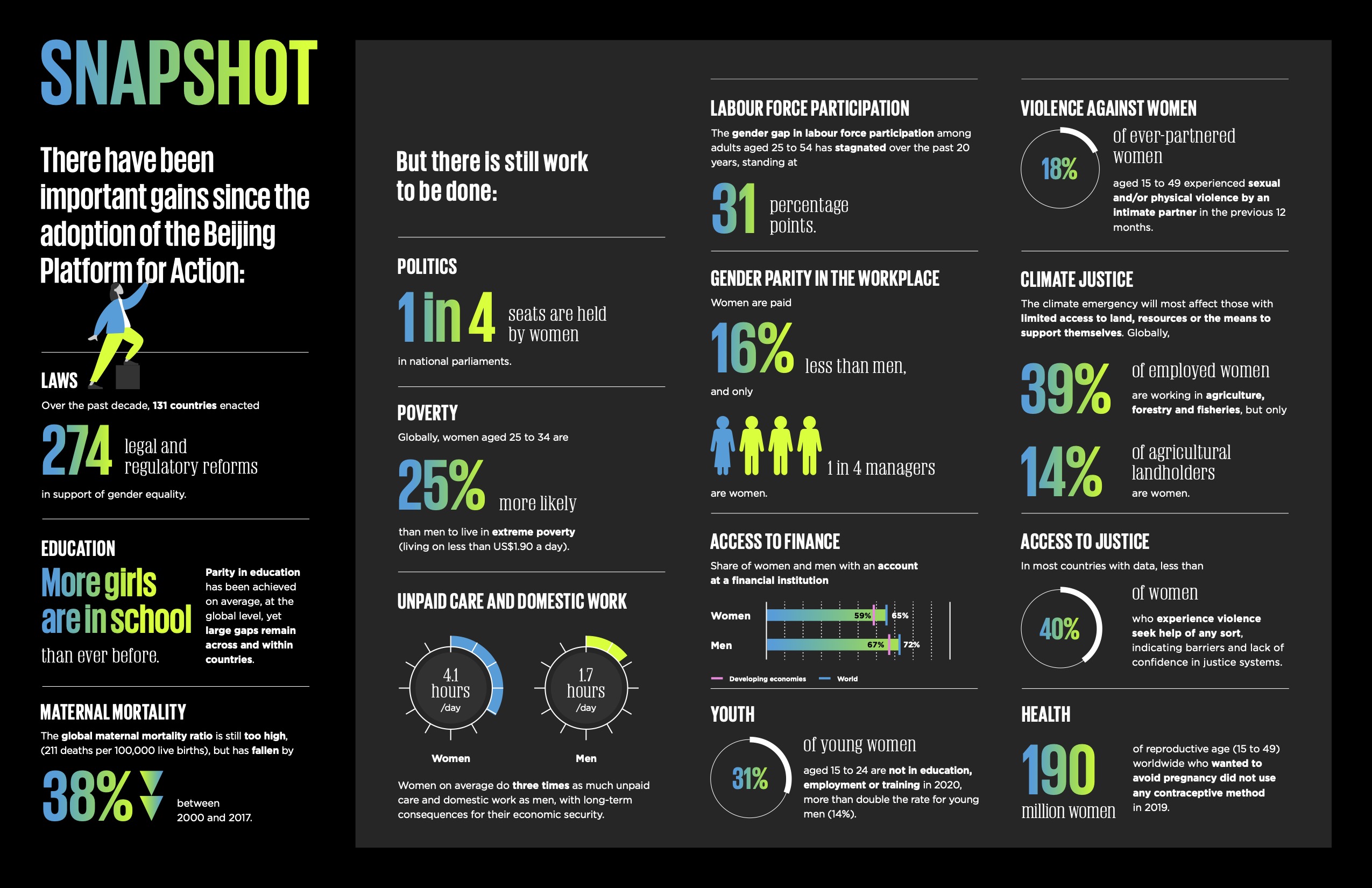Not only is gender equality a fundamental human right but it is also a pillar of creating a sustainable global system. Enshrined in the UN’s SDG 5 – Gender Equality – is a recognition that investing in environmental sustainability goes hand in hand with achieving global goals related to gender equality and vice-versa.
Overall, climate change has a greater impact on those members of society that are the most vulnerable and poor. In particular, those that depend on natural resources for their daily survival are often exposed to the effects of natural hazards and extreme weather events which are increasing in frequency and intensity due to climate change.
This has profound repercussions on discourses concerning gender equality as women make up 70% of the world’s poor, fill the majority of the world’s informal work and are highly active in economic sectors that are vulnerable to climate change – such as agriculture.

Although women are underrepresented in decision-making processes concerning environmental issues there are numerous studies that reveal how participation and leadership by women in environmental and conservation efforts can increase women’s political, economic, social and personal empowerment.
Furthermore, new research published in Nature Communications, and analysed by Carbon Brief, reveals that empowering women through improved healthcare, education, and representation in government has the potential to facilitate the way in which societies adapt to climate change.
When talking to Carbon Brief, Dr Astghik Mavisakalyan, a principal research fellow at Curtin University explains that there is a mutually beneficial relationship between gender equality and increased climate resilience. By making gains in one there is an improvement in the other which generates a “virtuous circle of sustainable and equitable development”.
Gender equality and climate change
Although it is undeniable that the last few decades have seen progress in gender equality – more girls accessing adequate education, fewer girls being forced to marry early, more women in positions of leadership, and legal actions to consolidate gender equality – it is also clear that systemic crises, such as the ongoing pandemic and climate change, lay bare the extent of inequalities.
The pandemic has exacerbated existing differences and threatens women and girls across a variety of issues – from health and the economy to security and social protection. In fact, the UN considers that the COVID-19 pandemic could reverse progress made on gender equality and women’s rights by exacerbating existing inequalities in the realms of health, the economy, security and social protection.
COVID-19: How women are bearing the burden of unpaid work https://t.co/w3x0AFDJrv #gender #covid19 pic.twitter.com/KuKME9WgZV
— World Economic Forum (@wef) February 25, 2021
In a similar fashion, the impacts of climate change also threaten to set back women more than men. Women are more likely to be involved in the provision and production of food, fetching of water and sourcing of fuel for cooking. These activities become increasingly challenging in a changing climate where extreme weather events – such as droughts flooding and heatwaves – impact the world’s poor in a more pronounced fashion. According to the International Union for Conservation of Nature (IUCN), 70% of the world’s poor are women.
Across the globe, women experience more barriers to owning land and their access to positions of power in political and financial decision making spheres are curtailed, which – amongst other things – prevents them from taking more active roles in climate change adaptation and mitigation initiatives.
The repercussions of gender inequality on the environment are a global concern. “Women have the knowledge and understanding of what is needed to adapt to changing environmental conditions and to come up with practical solutions. But they are still a largely untapped resource,” states the IUCN in its Gender and Climate Change brief.
A thriving trade in seaweed is fast taking root on the seabed of the East African coast. Geoffrey Kamadi travelled to Kenya to see why it is becoming a commercial venture of choice for many communities living along the Indian Ocean.https://t.co/cnsuojamt5
— Nextblue (@nextbluestories) March 2, 2021
Women and climate diplomacy
Until around 2008 the UN climate change negotiations included no specific references to gender issues and it was only in 2010 that the UN General Assembly unanimously voted to create a single body tasked with accelerating progress in achieving gender equality and women’s empowerment.
This has led to a shift in the understanding of the profound links between gender equality and responding to climate change. Just by way of example, the Lima Work Programme on Gender – adopted at COP20 in 2014 – promotes gender balance and achieving gender-responsive climate policy, and at COP21 in Paris a gender-responsive outcome has set the standard for implementation of the accord.
Although parties to the UNFCCC have officially recognized the importance of involving women and men equally in climate negotiations and the development and implementation of national climate policies – by establishing a dedicated agenda item under the Convention addressing issues of gender and climate change and through inclusion in the overarching text in the Paris Agreement – there is still much progress to be made.
In terms of national environmental ministries led by women, the statistics are far from positive. In 2015, the IUCN’s Environment and Gender Information data estimated that only 12% of 881 national environmental ministries (e.g., those related to natural resources, water, forests, etc.) across 193 countries were led by women.
One of the Sustainable Development Goals, Clean water and sanitation, is seen as essential for basic human rights to be fulfilled.
"We need to empower the voices of women within the water management sector to achieve this goal."https://t.co/NALwFp6gOR
— Nextblue (@nextbluestories) February 24, 2021
Although there has been progress over the last five years, whereby women now hold 15% of top jobs as ministers of environmental sectors and in 46 countries with forest-specific ministries, 18% are headed by women, and 11% of water or irrigation ministries are headed by women.
Gender equality leads to stronger climate action
Research indicates that, recognising the important contributions of women as decision makers, stakeholders, educators, carers and experts across sectors and at all levels can lead to successful, long-term solutions to climate change.
Setting in motion systems that allow women to put their capabilities to the service of climate goals can help create effective climate change adaptation and mitigation outcomesl. Not only have women demonstrated to be leading the way towards more equitable and sustainable solutions to climate change, but across sectors, women’s innovations and expertise have had transformational effects on lives and livelihoods, and increased climate resilience and overall well-being.
In West Africa, women have shown that their capability for developing and implementing solutions to increase sustainable livelihoods and reduce conflicts, whereas other examples reveal that women are more likely than men to use climate smart agriculture methods as a countermeasure to climate change.
"Climate change affects us all, but hits some harder than others. Africa is on the frontline of climate change" ⎯ @SigridKaag
Let's accelerate African adaptation together 🌍#climatechange #gender #Hupkaaghttps://t.co/SIe1x7JQfv
— Joep Janssen (@joepjanssencom) February 28, 2021
Furthermore, research indicates that when women are part of decision-making processes on land management, the groups in question conserve more. “The big takeaway here is that when it comes to environmental conservation, the presence of women matters,” says lead author of the study Nathan Cook, a postdoctoral research fellow at the Institute of Behavioral Science.
These contributions must also extend into the scientific, business and political decision-making fields for there to be real gender equality and true environmental gains. Just as with conservation, past studies demonstrate that countries with more female members of parliament are more likely to pass environmental treaties and promote conservation. Still further, there is a significant amount of research that demonstrate the benefits of gender equality in science.
Overall gender inequality is believed to have a negative impact on the resilience and adaptive capacity of women, families and communities. At the same time, there is growing evidence that it also impacts climate change mitigation and adaptiation. Linking gender equality with environmental agendas can provide a significant boost to sustainable and equitable development.






